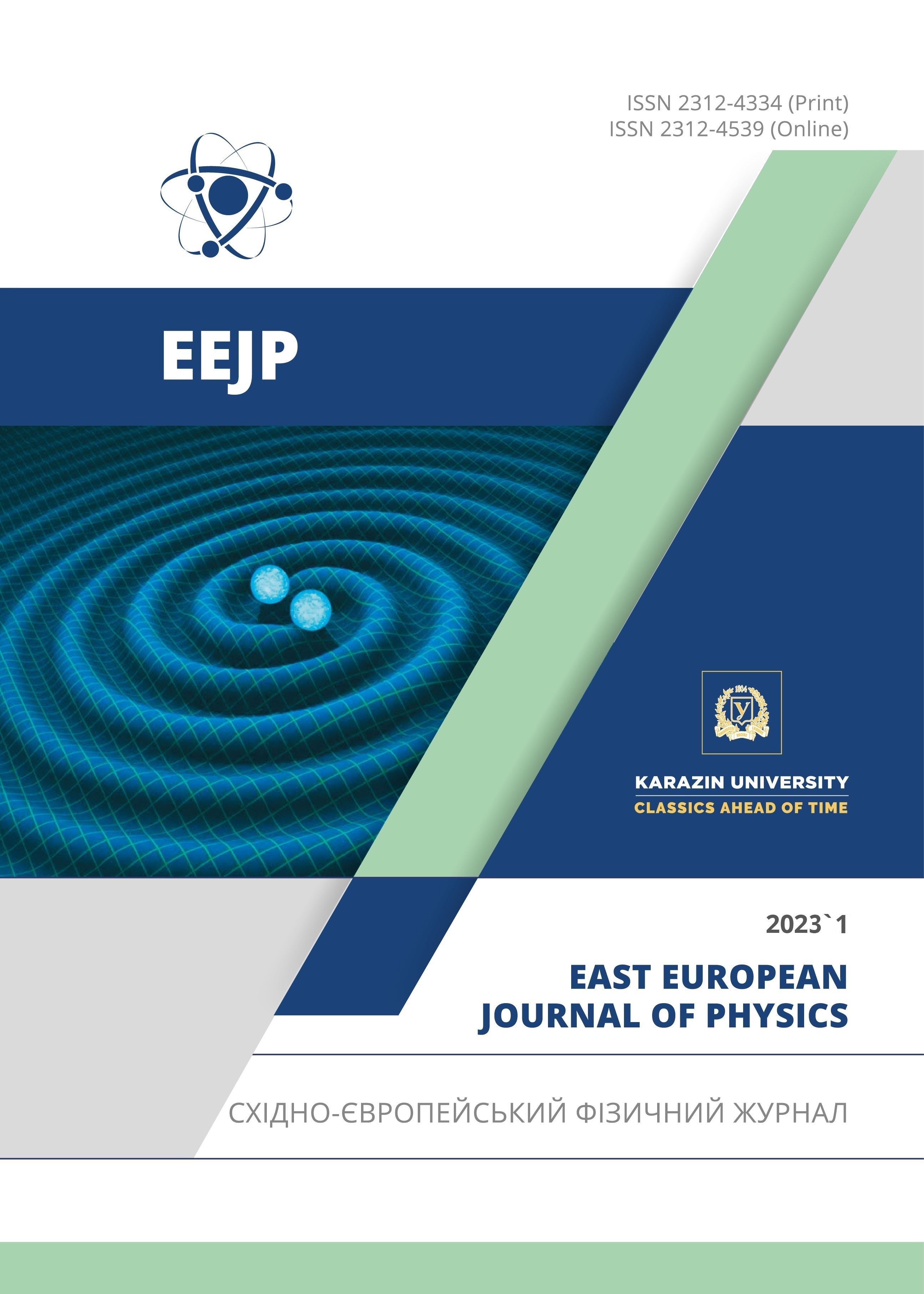Електронні та термодинамічні властивості потрійних рідкісноземельних сплавів
Анотація
У цій статті використовується підхід FP-LAPW в рамках методу DFT і квазігармонійна модель Дебая для дослідження електронних і термодинамічних властивостей інтерметалічних рідкоземельних матеріалів таких як SmInZn, SmInCd і SmTlZn. Термодинамічні властивості були визначені за допомогою квазігармонічної моделі Дебая, тоді як підходи FP-LAPW в рамках методу DFT були використані для отримання електронних властивостей. Розраховані структурні параметри та наявні експериментальні дані були досліджені, і було помічено, що існує хороша узгодженість між доступними експериментальними та розрахунковими значеннями структурних параметрів. Електронна поведінка сполук SmInZn, SmInCd та SmTlZn демонструє металевий характер. Ми розглянули кілька термодинамічних характеристик. Усі розраховані характеристики збігаються з експериментальними або теоретичними розрахунками.
Завантаження
Посилання
R.D. Hoffmann, and R. Pöttgen, Z. Kristallogr. 216, 127 (2001).
M.D. Klicpera, F. Malý, I. Puente-Orench, and P. Javorský, J. Alloys Compd. 822, 153595 (2020). https://doi.org/10.1016/j.jallcom.2019.153595
Mishra, U. Subbarao, S. Roy, S.C. Sarma, D. Mumaddi, S. Sarkar, and S.C. Peter, Inorg. Chem. 57, 12576 (2018). https://doi.org/10.1021/acs.inorgchem.8b01650
K. Sun, H. Yao, E. Fradkin, and S.A. Kivelson, Phys. Rev. Lett. 103, 046811 (2009). https://doi.org/10.1103/PhysRevLett.103.046811
L. Bessais, “Structure and Magnetic Properties of Intermetallic Rare-Earth-Transition-Metal Compounds: A Review”, Materials, 15, 201 (2022). https://doi.org/10.3390/ma15010201
E. Burzo, “Exchange Interactions and Transition Metal Moments in Rare-Earth Compounds”, J. Synchrotron Investig. 12, 431 (2018). https://doi.org/10.1134/S1027451018030072
M. Duchna, and I. Cieślik, “Rare Earth Elements in New Advanced Engineering Applications”, Rare Earth Elements - Emerging Advances, Technology Utilization, and Resource Procurement, (2022). https://doi.org/10.5772/intechopen.109248
M. Traore, A. Gong, Y. Wang, L. Qiu, Y. Bai, W. Zhao, Y. Liu, et al., “Research progress of rare earth separation methods and technologies”, Journal of Rare Earths, (2022). https://doi.org/10.1016/j.jre.2022.04.009
A. Fert, F.N. Van Dau, Comptes Rendus Physique, 20(7-8), 817 (2019). https://doi.org/10.1016/j.crhy.2019.05.020
V. Balaram, “Rare earth elements: A review of applications, occurrence, exploration, analysis, recycling, and environmental impact”, Geoscience Frontiers, 10(4), 1285 (2019). https://doi.org/10.1016/j.gsf.2018.12.005
G. Barakos, H. Mischo, and J. Gutzmer, A forward look into the US rare-earth industry; How potential mines can connect to the global REE market?, Mining Engineering, (2018), pp. 30-37. https://thoriumenergyalliance.com/wp-content/uploads/2020/02/REE-GeorgeNabeelhighlights.pdf
W. Gwenzi, L. Mangori, C. Danha, N. Chaukura, N. Dunjana, and E. Sanganyado, “Sources, behaviour, and environmental and human health risks of high-technology rare earth elements as emerging contaminants”, The Science of the Total Environment, 636, 299-313, (2018). https://doi.org/10.1016/j.scitotenv.2018.04.235
J. Kang, and A.M. Kang, “Trend of the research on rare earth elements in environmental science”, Environ. Sci. Pollut. Res. 27, 14318 (2020). https://doi.org/10.1007/s11356-020-08138-z
M.Y. Raïâ, R. Masrour, A. Jabar, M. Hamedoun, A. Rezzouk, A. Hourmatallah, N. Benzakour, et al., Journal of Physics and Chemistry of Solids, 163, 110581 (2022). https://doi.org/10.1016/j.jpcs.2022.110581
M. Jirsa, M. Rameš, and M. Muralidhar, Acta Phys. Pol. A, 113, 223 (2008). http://przyrbwn.icm.edu.pl/APP/PDF/113/a113z1054.pdf
D.J. Garcı́a, V. Vildosola, and P. Cornaglia, Condensed Matter, 32(28), 285803 (2019). https://doi.org/10.1088/1361-648X/ab7e5a
X.B. Liu, and Z. Altounian, “First-principles calculation on the Curie temperature of GdFeSi”, J. Appl. Phys. 107, 09E103 (2010). https://doi.org/10.1063/1.3364048
S. Talakesh, and Z. Nourbakhsh, “The density functional study of structural, electronic, magnetic and Thermodynamic properties of XFeSi (X=Gd, Tb, La) and GdRuSi compounds”, J. Supercond. Novel Magn. 30, 2143 (2017). https://doi.org/10.1007/s10948-017-3976-x
V.K. Pecharsky, and K.A. Gschneidner Jr, “Magnetocaloric effect and magnetic refrigeration”, J. Magn. Magn. Mater. 44-56, 200 (1999). https://doi.org/10.1016/S0304-8853(99)00397-2
J. Du, Q. Zheng, Y. Li, Q. Zhang, D. Li, and Z. Zhang, “Large magnetocaloric effect and enhanced magnetic refrigeration in ternary Gd-based bulk metallic glasses”, J. Appl. Phys. 103, 023918 (2008). https://doi.org/10.1063/1.2836956
V. Franco, J.S. Blázquez, J.J. Ipus, J.Y. Law, L.M. Moreno-Ramírez, and A. Conde, Prog. Mater. Sci. 93, 112 (2018). https://doi.org/10.1016/j.pmatsci.2017.10.005
A. Mahmood, M. Rashid, K. Safder, M.W. Iqbal, N.A. Noor, S.M. Ramay, W. Al-Masry, et al., Results in Physics, 20, 103709 (2021). https://doi.org/10.1016/j.rinp.2020.103709
P. Blaha, K. Schwarz, G.K.H. Madsen, D. Kuasnicka, and J. Luitz, WIEN2k An Augmented Plane Wave-Local Orbitals Program for Calculating Crystal Properties, (K. Schwarz Technical Universitat, Wien Austria, 2001). ISBN: 3-9501031 1-2
D.J. Singh, and L. Nordstrom, Plane Waves Pseudo Potentials and the LAPW Method, (Springer, New York, 2006).
K. Schwarz, “DFT calculations of solids with LAPW and WIEN2k”, J. Solid State Chemistry, 176, 319 (2003). https://doi.org/10.1016/S0022-4596(03)00213-5
A. Otero-de-la-Roza, and, D. Abbasi-Pérez, and V. Luaña, “GIBBS2: A new version of the quasiharmonic model code. II. Models for solid-state thermodynamics, features, and implementation”, Computer Physics Communications, 182. 2232 (2011). https://doi.org/10.1016/j.cpc.2011.05.009
W. Kohn, and L.J. Sham, Phys. Rev. 140, A1133 (1965). https://doi.org/10.1103/PhysRev.140.A1133
P. Blaha, K. Schwarz, G.K.H. Madsen, D. Kvasnicka, and J. Luitz, WIEN2k, An Augmented Plane Wave Plus Local Orbital Program for Calculating Crystal Properties, (Vienna University of Technology, Vienna, 2001).
J.P. Perdew, K. Burke, and M. Ernzerhof, Phys. Rev. Lett. 77, 3865 (1996). https://doi.org/10.1103/PhysRevLett.77.3865
F.D. Murnaghan, Proc. Natl. Acad. Sci. U.S.A. 30, 244 (1994). https://doi.org/10.1073%2Fpnas.30.9.244
K. Hartjes, and W. Jeitschko, J. Alloys Compd. 226, 81 (1995). https://doi.org/10.1016/0925-8388(95)01573-6
Авторське право (c) 2023 Аман Кумар, Анудж Кумар, Камал Кумар, Ріші Пал Сінгх, Ріту Сінгх, Раджеш Кумар

Цю роботу ліцензовано за Міжнародня ліцензія Creative Commons Attribution 4.0.
Автори, які публікуються у цьому журналі, погоджуються з наступними умовами:
- Автори залишають за собою право на авторство своєї роботи та передають журналу право першої публікації цієї роботи на умовах ліцензії Creative Commons Attribution License, котра дозволяє іншим особам вільно розповсюджувати опубліковану роботу з обов'язковим посиланням на авторів оригінальної роботи та першу публікацію роботи у цьому журналі.
- Автори мають право укладати самостійні додаткові угоди щодо неексклюзивного розповсюдження роботи у тому вигляді, в якому вона була опублікована цим журналом (наприклад, розміщувати роботу в електронному сховищі установи або публікувати у складі монографії), за умови збереження посилання на першу публікацію роботи у цьому журналі.
- Політика журналу дозволяє і заохочує розміщення авторами в мережі Інтернет (наприклад, у сховищах установ або на особистих веб-сайтах) рукопису роботи, як до подання цього рукопису до редакції, так і під час його редакційного опрацювання, оскільки це сприяє виникненню продуктивної наукової дискусії та позитивно позначається на оперативності та динаміці цитування опублікованої роботи (див. The Effect of Open Access).








